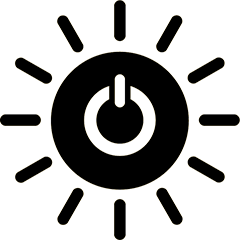UN Sustainable Development Goals Addressed
-

Goal 4: Quality Education
-

Goal 5: Gender Equality
-

Goal 7: Affordable & Clean Energy
-

Goal 16: Peace, Justice & Strong Institutions
2020 Global Design Challenge Finalist
This design concept was developed by participants in the Institute’s Global Design Challenge. The descriptions below are from the team’s competition entry materials.
Location: Ithaca, NY, United States
Team members: Hannah Bidigare-Curtis, Michael Darfler, Patricia Heye
Innovation Details
Powered by solar panels that are protected by hard outer shells like a ladybug’s elytra, or wing cases, ELIGHTRA is an environmentally-friendly lighting solution that helps build resilient communities. This innovative, community-focused solution provides light and energy to refugees living in “temporary” camps, bringing displaced peoples together within temporary settlements.
What is the problem you are trying to solve and how is it related to the united nations sustainable development goals?
The number of refugees worldwide has increased dramatically over the past 15 years, and as climate change forces more people from their homes, that number will grow to over 150 million forcibly displaced people by 2050. Government, non-governmental, and humanitarian aid organizations are scrambling to meet the needs of these individuals, but resources are scarce and time is of the essence. When there is not enough housing for these displaced people, “temporary” refugee camps and settlements are established to house them in settings that fail to create a sense of community or develop strong interpersonal relationships, both of which are critical for individuals looking to rebuild their lives and support their families. ELIGHTRA aims to provide community-scale lighting that fosters a safe, inclusive, equitable, and resilient environment in refugee camps.
What organisms/natural systems did you learn from and how did what you learned inform your design?
The primary inspiration for the design came from Coccinella septempunctata, the common ladybug. Like C. septempunctata, the solar panels of ELIGHTRA are able to unfold to increase surface area during the day and fold back in at night to reduce the footprint. ELIGHTRA’s outer shell is modeled after the ladybug’s hard outer shell, or elytra, from which the product gets its name. The design of the light was informed by the evolutionary innovations of bioluminescent creatures. Hinea brasiliana, also known as the Clusterwink Snail, has a unique shell structure that acts as a light diffuser, causing the entire shell to glow from a light source in its mantle. This was incorporated in the protective elytra to act as a diffuser, providing an even and inviting light. The last organisms that informed ELIGHTRA’s design are two sea dwellers, bioluminescent krill (Euphausia superba) and the Madeira lanternfish (Ceratoscopelus maderensis). Each of these organisms has evolved different bioluminescent organelles that effectively produce, capture, and direct light to maximize intensity while minimizing energy. Like the photophore of E. superba, ELIGHTRA’s light source comes from an array of lights contained in a reflective parabolic dish to maximize directed light output. The light then passes through a biconvex lens inspired by the photophore of C. maderensis, evenly distributing the light across the entire surface of the outer shell.
What does your design solution do? How does it address the problem or opportunity you selected?
ELIGHTRA builds resilience by facilitating interaction through the power of light. Rather than focusing on deficit-based strategies that provide the bare minimum for survival and victimize already vulnerable populations, humanitarian efforts must be proactive and focus on building community resilience and the inherent abilities of communities to respond in disaster situations. Networks of social support, a key social determinant of health and well-being, give people the practical and emotional resources they need to be resilient. Studies have shown that community lighting in refugee camps is associated with increased nighttime communal activities such as studying, playing, knitting, preparing food, and eating. Facilitating these interactions through communal lighting interventions builds strong social networks, increases feelings of safety, reduces crime, and fosters community resilience, resulting in more positive outcomes for displaced individuals. While much good is accomplished through these community-wide installations, their implementation can be problematic. The planning phase often neglects to take into account the needs and expertise of the refugee community, resulting in the suboptimal distribution of resources. Furthermore, because the lighting infrastructure is owned and operated by the camp, refugees continue to be seen through the lens of deficit aid. ELIGHTRA’s unique design enables it to be placed where it is needed most and the flexibility to accommodate changes to the settlement’s population and layout. ELIGHTRA’s solar panels also collect and store enough energy to enable refugees to charge their electronic devices and barter for other resources with surplus energy, thereby fitting into the settlement’s informal economy. Switching to renewable energy sources for lighting would also greatly improve health outcomes for children within the home, reduce the risk of injury in the community, and decrease the amount of pollution and CO2 being emitted into the atmosphere.


